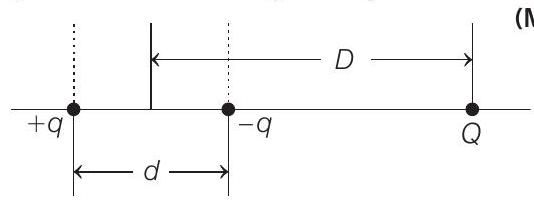Electrostatics 2 Question 2
2. A system of three charges are placed as shown in the figure

(Main 2019, 9 April I)
If $D»d$, the potential energy of the system is best given by
(a) $\frac{1}{4 \pi \varepsilon_{0}} \Big[-\frac{q^{2}}{d}+\frac{2 q Q d}{D^{2}}\Big]$
(b) $\frac{1}{4 \pi \varepsilon_{0}} \Big[+\frac{q^{2}}{d}+\frac{q Q d}{D^{2}}\Big]$
(c) $\frac{1}{4 \pi \varepsilon_{0}} \Big[-\frac{q^{2}}{d}-\frac{q Q d}{2 D^{2}}\Big]$
(d) $\frac{1}{4 \pi \varepsilon_{0}} \Big[-\frac{q^{2}}{d}-\frac{q Q d}{D^{2}}\Big]$
Show Answer
Answer:
Correct Answer: 2. (d)
Solution:
- The system of two charges, i.e. $+q$ and $-q$ that are separated by distance $d$ can be considered as a dipole. Thus, the charge $Q$ would be at $D$ distance from the centre of an electric dipole on its axial line.
So, the total potential energy of the system will be due to two components.
(1) Potential energy of dipole’s own system
$$ \stackrel{(\mathrm{PE}){1}=\frac{K q{1} q_{2}}{d}=-\frac{K q^{2}}{d}}{\stackrel{\bullet}{\stackrel{q}{\longleftarrow}}+\stackrel{+q}{\longrightarrow}} $$
(2) Potential energy of charge $Q$ and dipole system
$$ (\mathrm{PE})_{2}=-\frac{K Q q}{D^{2}} \cdot d $$
Hence, total potential energy of the system
$$ \begin{aligned} (\mathrm{PE}) _ {\text {total }} & =(\mathrm{PE}) _ {1}+(\mathrm{PE}) _ {2}=-\frac{K q^{2}}{d}-\frac{K Q q}{D^{2}} \cdot d \\ \Rightarrow \quad(\mathrm{PE}) _ {\text {total }} & =-\frac{1}{4 \pi \varepsilon _ {0}} \Big[\frac{q^{2}}{d}+\frac{Q q d}{D^{2}}\Big] \end{aligned} $$






